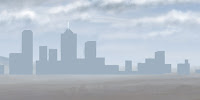 Here is my horizon so far. The ground and mountains are little more than quick scribbles at this point. You can also see some of the remnants of a rough city sketch from earlier in the process. I need to create a more structured, architectural shape for the final city. To do that, I'm going to use a technique I learned from the great matte painter Dylan Cole. He starts with a basic silhouette made quickly with the Rectangular Marquee tool. I've gone one step beyond that by using the Polygonal Lasso to add some angles. Then make a new layer and fill it with a bluish grey with the selection active. If you want to paint the spire white for some reason, go ahead. I did this image a few years ago. When I do this kind of thing now, I use a vector Shape layer because it allows greater flexibility and control in editing the shapes and their color.
Here is my horizon so far. The ground and mountains are little more than quick scribbles at this point. You can also see some of the remnants of a rough city sketch from earlier in the process. I need to create a more structured, architectural shape for the final city. To do that, I'm going to use a technique I learned from the great matte painter Dylan Cole. He starts with a basic silhouette made quickly with the Rectangular Marquee tool. I've gone one step beyond that by using the Polygonal Lasso to add some angles. Then make a new layer and fill it with a bluish grey with the selection active. If you want to paint the spire white for some reason, go ahead. I did this image a few years ago. When I do this kind of thing now, I use a vector Shape layer because it allows greater flexibility and control in editing the shapes and their color.Next, add a layer effect. At the very least, you need a Gradient Overlay. Take a look at distant mountains and cityscapes; they get progressively lighter as they approach the horizon. You can simulate this with a vertical gradient that fades up to transparent. The easiest (not the only) way to use a custom gradient is to pick the color you want as your foreground color before opening the Layer Style options. When you click on your gradient options, it's already there. I almost always exclusively use foreground to transparent gradients. Depending on your lighting situation, you may also want to try an Inner Glow, Inner Shadow, or Bevel and Emboss. Picking the sky color as a Color Overlay effect is an easy way to push it back in perspective.
Make a new layer and clip it to the city layer. This upper layer will hold the building textures and details. If the city is far away in the distance or does not need to look photo-realistic, it's easy enough to hand paint the details with a small, simple brush. Have some fun and be a little loose; all you really need to do here is hint at the architecture. Hold down the Shift key as you paint to get perfectly straight horizontal or vertical lines. I also added some crisp 1-pixel rules with the Line tool set to raster mode. Even though the real colors of these buildings have white, grey, black, tan, brick red, and others, you'll see that all the colors I've painted here are quite blue. This is because of their distance from the viewer. You could also paint them more accurately or use photo textures and use the Color Overlay effect on the clipping mask layer to knock them back as much as you want. How does this work when the layer style is just on the bottom layer and you are painting or texturing on layers above it? The answer is the clipping mask. As one past student of mine put it, all the clipped layers 'inherit' the settings of the clipping mask layer. This includes Opacity, Fill, blending mode, Blend If settings, and Layer Styles. That's why, generally speaking, the clipping mask layer should be Normal blending mode and 100% Opacity and Fill. Notice that the fading gradient of the city silhouette also affects the painted building textures, even though they are on a layer above it.This would be the same for other interior effects like Inner Shadow, Inner Glow, Inner Bevel, Pattern Overlay, and so on.
The city looks okay, but I'd like it to have a bit more depth, so I have added another set of building silhouette and texture layers. You'll see that these colors are a little brighter and more saturated to bring them forward just a bit more. You could keep doing this to create additional depth if needed, but for my purposes, these two levels did the trick.
The last thing to do is to attach the city sitting on the horizon to the dirt in the foreground. This is done by continuing the city elements along the ground. Try some very loose painting here; all you need to do is suggest things like trees, houses, roads, parks, and other suburban buildings. You can also increase the saturation and value of the colors to bring them forward even more. All I have done is hint at what might be here in the outskirts of the city. Your brain fills in the rest and you probably think you are seeing more detail than is actually there, especially when it gets zoomed out. That's it; the city is now built. In the next tutorial, I'll cover texturing closeup items with more detail.











Nice Article
ReplyDelete